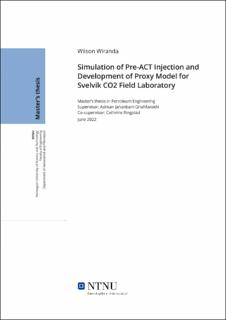| dc.description.abstract | A small-scale CO2 field laboratory was established in Svelvik, Norway, from 2009 to 2013. The site was characterized during 2009 and 2010, starting from drilling, sampling and logging from Svelvik#1 exploration well. In 2012, Svelvik#2 was drilled as the main CO2 injector with the completed interval on the depth of 64-65m.
The main objectives of this study are: to build a history match model based on the Pre-ACT 2019 injection data, understand the uncertainties and finally develop a proxy model that can mimic the numerical simulation result of the Svelvik CO2 field laboratory. The proxy model can be used to design the CO2 injection rate for the next injection campaign and be input for updating the reservoir model. With the proxy model availability, the previous numerical simulation of Svelvik CO2 injection that requires hours to obtain results can be reduced to seconds.
After the model is history matched, the prediction scenario is designed as two cycles of injections with the duration of 1 week of injection and 1 week of shut-in period for each cycle. The CO2 injection rate is designed by using a modified fractional factorial sampling. 18 different injection cases were simulated and the results are used for training proxy models. A proxy model is defined as a function that approximates the response of the full physics model for a given set of input values. The proxy models used in this study are response surface proxy and universal kriging proxy. The inputs for the proxy models are 1st and 2nd CO2 injection rate, and several outputs are predicted, from bottomhole pressure, average field pressure, dissolved CO2 in water and CO2 in gas phase. The validity of the proxy models is evaluated by percent error and correlation coefficient (R2).
The results of this study show that, there is still no simulation case that successfully matches the measured data. The best history match case, which requires the absolute permeability multiplied by 5, has an average percent error of 0.22% (0.016 bar) and maximum percent error of 1.01% (0.074 bar) with respect to the measured injection well bottomhole pressure. It implies that the permeability in the current geo-model needs to be improved in the permeability model. The history match result also shows the requirement to modify the previously interpreted mud layer (50.7m to 61.2m) to a non-continuous mud layer that contains sand lobes due to the fact that in the monitoring results, the CO2 is able to migrate to the upper layer which requires a pathway to reach (~38m depth).
The proxy models from the response surface and universal kriging method show a promising result from the validation cases and evaluation cases. All predicted results have R2 over 0.99, which means that the proxy models are highly correlated to the simulation results. The universal kriging proxy shows a better performance than the response surface due to the limitation of the response surface in following the polynomial regression model, while the universal kriging has the potential to minimize the error through the Gaussian process.
Overall, this study provides a better understanding of the Svelvik CO2 field laboratory and successfully developed the proxy models to be implemented for designing the next injection campaign or optimization cases in further work. | |
